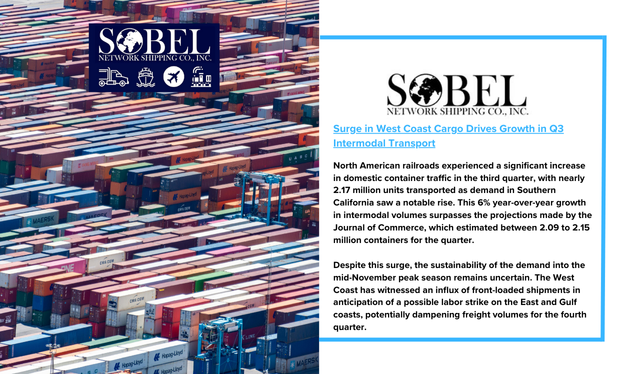North American railroads experienced a significant increase in domestic container traffic in the third quarter, with nearly 2.17 million units transported as demand in Southern California saw a notable rise. This 6% year-over-year growth in intermodal volumes surpasses the projections made by the Journal of Commerce, which estimated between 2.09 to 2.15 million containers for the quarter.
Despite this surge, the sustainability of the demand into the mid-November peak season remains uncertain. The West Coast has witnessed an influx of front-loaded shipments in anticipation of a possible labor strike on the East and Gulf coasts, potentially dampening freight volumes for the fourth quarter.
Over the past seven years, domestic container volumes have fluctuated during the peak season—typically increasing in August, declining in September, and picking up again in October before dropping off in the final two months of the year. This pattern was evident in the current year as well, with a 4.3% increase in August followed by a 5.6% decrease in September, according to data from the Intermodal Association of North America (IANA).
September, however, saw the ports of Los Angeles and Long Beach handling record volumes, suggesting that the typical seasonal trends might persist. Darren Field, President of J.B. Hunt’s intermodal division, expressed uncertainty about the future, noting that some freight was preemptively shifted from the east to the west due to the strike concerns. Despite the uncertainty, many customers are hopeful for a standard peak season through the fourth quarter.
Southern California specifically saw significant growth, with domestic container volumes increasing by double digits in July and August. This boost contributed to J.B. Hunt’s third-quarter growth, which was significantly higher in Southern California compared to the national average.
In response to the increased demand, J.B. Hunt, along with competitors like Hub Group and Schneider National, implemented surcharges in Los Angeles for shippers exceeding their contractual volume. Some of these surcharges exceeded $1,000 per container.
CSX Transportation also noted a shift in volume from east to west in their third-quarter report, with overall intermodal volumes up 3% but domestic volumes remaining steady.
On the service side, despite some delays and minor issues in container handling in Southern California, domestic intermodal service has remained relatively consistent. The Pacific Merchant Shipper Association reported that the average dwell time for rail-bound containers at Los Angeles and Long Beach ports reached 9.25 days in September, the highest since October 2022.
Union Pacific Railroad has faced challenges with delays in Tacoma, particularly with intermodal transport. However, domestic intermodal providers have reassured that, despite occasional setbacks, the railroads continue to efficiently move 53-foot domestic containers.
This period represents a crucial test for J.B. Hunt and its rail partners, as they strive to handle the increased volume while maintaining reliable service. The effective handling of this surge not only supports the case for the growth of intermodal transport but also solidifies its position as a viable alternative to over-the-road freight, as recognized by many shippers.


